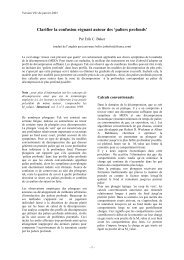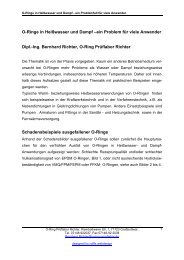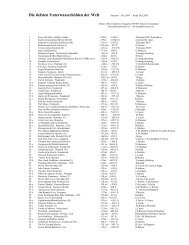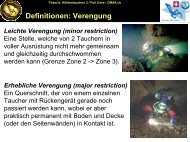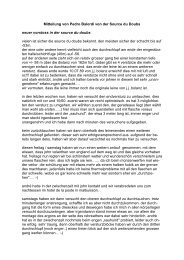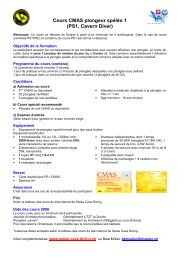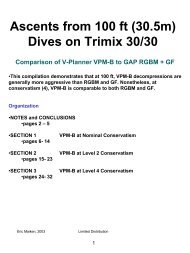cave diving and the nss - bei Swiss-Cave-Diving
cave diving and the nss - bei Swiss-Cave-Diving
cave diving and the nss - bei Swiss-Cave-Diving
You also want an ePaper? Increase the reach of your titles
YUMPU automatically turns print PDFs into web optimized ePapers that Google loves.
14 CAVE DIVING COMMUNICATIONS<br />
"Okay" sign, he is signifying that<br />
he is okay <strong>and</strong> asking if you are<br />
all right. In this instance, <strong>the</strong><br />
"Okay" sign functions as a comm<strong>and</strong><br />
sign <strong>and</strong> you must answer.<br />
If you are, in fact, perfectly all<br />
right, with no objections to proceeding<br />
with <strong>the</strong> dive, <strong>the</strong>n <strong>the</strong><br />
appropriate response is a return<br />
"Okay" signal. In <strong>the</strong>se instances<br />
it makes no difference whe<strong>the</strong>r<br />
that "Okay" is delivered by light or<br />
h<strong>and</strong>.<br />
Your buddy's failure to respond<br />
to your "Okay" is an indication ei<strong>the</strong>r that he has not seen<br />
your signal or that he. is experiencing some sort of difficulty. Assume<br />
that a problem exists unless you have some reason to<br />
believe o<strong>the</strong>rwise. A team of highly experienced <strong>cave</strong> divers who<br />
are negotiating a tight, silty restriction are obviously not going to<br />
expect to be able to see <strong>and</strong> h<strong>and</strong> signal each o<strong>the</strong>r at all times.<br />
But in large <strong>cave</strong> with good visibility, <strong>the</strong> failure of a buddy who is<br />
close by to acknowledge your h<strong>and</strong> signals <strong>and</strong> queries (or who<br />
acknowledges <strong>the</strong>m improperly, with a nod of <strong>the</strong> head, for example)<br />
is cause for immediate concern. The dive should be<br />
stopped, <strong>the</strong> source of <strong>the</strong> problem investigated, <strong>and</strong> appropriate<br />
measures taken.<br />
O<strong>the</strong>r absolute, undisputed comm<strong>and</strong> signs are "Surface" <strong>and</strong><br />
"Hold." "Surface" indicates that<br />
<strong>the</strong> diver is calling <strong>the</strong> dive <strong>and</strong><br />
requesting that <strong>the</strong> team return to<br />
<strong>the</strong> surface. "Hold" asks for a<br />
temporary stop. Both of <strong>the</strong>se<br />
can be initial signals, or responses<br />
to an "Okay" query. The<br />
diver receiving ei<strong>the</strong>r <strong>the</strong> "Surface"<br />
or "Hold" signal should repeat<br />
it back to <strong>the</strong> diver initiating<br />
it to signify comprehension <strong>and</strong><br />
compliance. If <strong>the</strong>re are o<strong>the</strong>r<br />
buddies in <strong>the</strong> team, <strong>the</strong>y should<br />
HAND SIGNALS 15<br />
be contacted <strong>and</strong> <strong>the</strong> process repeated,<br />
until all <strong>the</strong> team members<br />
underst<strong>and</strong> that <strong>the</strong> dive is ei<strong>the</strong>r<br />
<strong>bei</strong>ng turned around or temporarily<br />
stopped. Both signals have <strong>the</strong><br />
force of royal comm<strong>and</strong> <strong>and</strong> are<br />
not open to debate.<br />
Both signals can indicate<br />
serious problems, however. If <strong>the</strong><br />
dive is <strong>bei</strong>ng called because one<br />
of <strong>the</strong> divers has reached his preestablished<br />
turn pressure, this is a<br />
completely normal event. After all,<br />
somebody has to turn <strong>the</strong> dive. But supposing <strong>the</strong> diver signals<br />
"Surface" because of <strong>the</strong> failure of a critical item of gear, such as<br />
a primary light, or because he is feeling scared or is physically<br />
exhausted. This additional level of stress places <strong>the</strong> team slightly<br />
more at risk. If <strong>the</strong> stressed diver's buddies are aware not only<br />
that a problem exists, but what it is, <strong>the</strong>y will be that much more<br />
prepared to h<strong>and</strong>le any additional problem that might arise as a<br />
consequence or to give moral support (e.g., by staying closer to<br />
<strong>the</strong> stressed diver, letting him see that <strong>the</strong>y are watching him closely<br />
<strong>and</strong> are ready to lend assistance, etc.).<br />
The calmness or violence of <strong>the</strong> "Surface" signal is also a<br />
pretty good indication that ei<strong>the</strong>r all is well or something is wrong.<br />
With new <strong>cave</strong> divers, sudden attacks of <strong>the</strong> heebie jeebies are not<br />
uncommon. If such a diver signals fairly emphatically to turn <strong>the</strong><br />
dive way before prearranged air or time turns, you may want to be<br />
alert for subtle signs of distress or difficulty.<br />
There is one additional consideration, however. If a diver<br />
turns <strong>the</strong> dive, not because of air, but because he is feeling uneasy,<br />
due, say, to <strong>the</strong> penetration distance, that diver may, later on in <strong>the</strong><br />
dive, indicate that he is now feeliing better about things <strong>and</strong> that<br />
it's all right with him if <strong>the</strong> team turns around <strong>and</strong> heads back into<br />
<strong>the</strong> <strong>cave</strong>. This may seem a little peculiar, but it has been known<br />
to happen, even two or three times on a single dive, especially with<br />
<strong>cave</strong> divers who are trying to be careful not to dive beyond <strong>the</strong>ir<br />
psychological limits.<br />
As long as <strong>the</strong> team is well within its air turnaround parameters<br />
(<strong>and</strong> <strong>the</strong> o<strong>the</strong>r divers are comfortable with <strong>the</strong> idea <strong>and</strong>




